With so many of us working from home these days, we now have more apps than ever careening across our household Wi-Fi networks. And some of these require not only a good amount of bandwidth, but steady bandwidth. When they don't have it, that chat you're having with your boss on your company's voice over IP (VoIP) phone system suddenly sounds like you're underwater. The same goes for many consumer-grade apps, especially video streaming services like Netflix, and certainly the latest games.
Most folks figure they need to upgrade their Wi-Fi in this situation, so they either buy a new Wi-Fi router or upgrade their internet service (or both). Chances are, an under-$100 range extender will get the job done. Aptly named, range extenders pick up your router's Wi-Fi signal, amplify it, and rebroadcast the boosted signal. Our top-rated models are below, followed by a detailed guide to selecting the range extender that meets the needs of your home.
What makes range extenders so attractive compared with a bespoke mesh system is that they are easy to install and inexpensive. When paired with a budget-priced router, you can build a tandem system with coverage that rivals what you'd get from a single high-priced router or mesh network. Range extenders come in various shapes, sizes, and speeds, but they do have their limitations; they are typically half as fast as your primary router, and they create a separate extended network that makes seamless roaming difficult.
Depending on the size and layout of your home, a mid-to-high-end router may provide all the Wi-Fi coverage you'll need. But for homes built with dense materials like brick, concrete, plaster, and metal, some level of signal degradation is almost a certainty. Likewise, homes with multiple floors and many walls are more susceptible to signal loss than a one-story home with an open floor plan. In some cases, you can relocate your router to a central location to deliver a stronger signal to those dead zones that were previously out of reach. In most homes, however, the router's location is tied to the room where the internet enters the house, which means relocating the router will likely require running an Ethernet cable to the desired area. Range extenders provide a relatively easy way to deliver Wi-Fi without having to run cables.
(Credit: TP-Link)When shopping for a range extender, it's important to find one that matches your router's specs. For example, if you have a dual-band AC1900 router, get a dual-band AC1900 extender (or better). If your router supports Multi-User Multiple Input Multiple Output (MU-MIMO) data streaming, which provides enhanced performance by sending data to compatible clients simultaneously rather than sequentially, look for an extender that supports this technology if you want to extend your MU-MIMO network.
The same goes for the latest Wi-Fi 6 and Wi-Fi 6E technologies, the current fastest flavors of Wi-Fi. If you recently bought a new router that supports these standards, you'll certainly want to make sure any range extenders support them as well.
Do You Need a Desktop or Plug-In Extender?
There are two types of Wi-Fi range extenders: desktop and plug-in. Most desktop extenders look just like a wireless router and are typically equipped with external adjustable antennas, multiple LAN ports for connecting to devices like TVs and gaming consoles, and USB ports for attaching to peripherals such as storage drives and printers.
Plug-in extenders are much smaller than their desktop counterparts and are inserted right into a wall outlet. Some models have external antennas, while others use internal antennas to present an unobtrusive profile. Due to their size, plug-in extenders usually have only a single LAN port and lack USB connectivity, making them less versatile but more affordable than desktop extenders. If you can't spare a wall outlet, look for a plug-in model that offers a pass-through outlet.
(Credit: Amped Wireless)It's also worth noting that, if you're having the rather specific issue of connecting a computer to Wi-Fi in a particular part of your home, you might be better served by a USB Wi-Fi adapter. For as little as $15, these adapters are essentially antennas that plug directly into your computer to help it pull in a better Wi-Fi signal.
How to Set Up a Wireless Range Extender
Not very long ago, setting up a range extender required a bit of technical expertise and a good deal of patience to find the best location (ideally halfway between the router and the dead zone). But most of today's routers and range extenders support Wi-Fi Protected Setup (WPS), which makes pairing the two as simple as pressing a couple of buttons, naming your new extended network, and creating a network password.
Moreover, nearly all manufacturers offer web-based setup wizards and illustrated instructions that will help you configure basic wireless settings. Some (but not all) extenders are equipped with LED status indicators that tell you if the extender is too far from the router. Extenders can also offer advanced router-like features such as guest networking, access scheduling, and media server capabilities.
What Can't Wi-Fi Range Extenders Do?
While fairly easy to configure, range extenders have their limitations. They often use a separate network SSID that you have to log into as you move through the house, and Wi-Fi speeds are typically half of what you get from your main router. Most dual-band extenders use both radio bands to transmit data to and from the router, which means devices connecting to the extender are competing for bandwidth with the router. To help alleviate network congestion, some manufacturers let you dedicate a band for router-to-extender communications. Netgear's Fastlane technology and Amped Wireless' BoostBand technology are good examples.
Still, maybe the fastest possible throughput is what you're after. That could be because you're running business applications across your network, or because you're in the market for a gaming router or especially a Wi-Fi 6 router. If so, be sure to test the connection between your endpoints to ensure you're getting the maximum traffic speeds you can. PCMag thoroughly tests all routers and range extenders that come through its doors so you'll have a good idea of what to expect before you buy.
(Credit: Linksys)Wireless Extenders vs. Wi-Fi Mesh Systems
If you're considering upgrading your network with all new hardware, it's worth looking into a mesh-based Wi-Fi system before you spend money on a traditional router. Wi-Fi mesh systems are designed to blanket your home with wireless coverage and are made up of several networking components, including a main router and a series of satellite modules, or nodes, that you place throughout your home. They are all part of a single wireless network and share the same SSID and password, which means you can roam throughout your house without having to log into an extended network.
Whereas range extenders communicate with the router via the 2.4GHz or 5GHz radio bands, most Wi-Fi system satellites use mesh technology to talk to the router, and to each other. Each node serves as a hop point for other nodes in the system, which helps the nodes farthest from the router to deliver a strong Wi-Fi signal as they talk to other nodes and don't rely on one-to-one communications with the router.
Wi-Fi mesh systems are ideal for users with little or no technical knowledge. They can be installed in minutes and typically come with a user-friendly mobile app that walks you through the installation process with easy-to-follow illustrated instructions. And their prices are coming down, too.
So, Which Wi-Fi Range Extender Should I Buy?
In our wireless-extender review summaries above and our spec comparison chart below, check out our picks for the top extenders we have tested. To get even more from your home Wi-Fi network, also check out our guides to setting up your router, boosting your signal, and protecting your Wi-Fi network.









